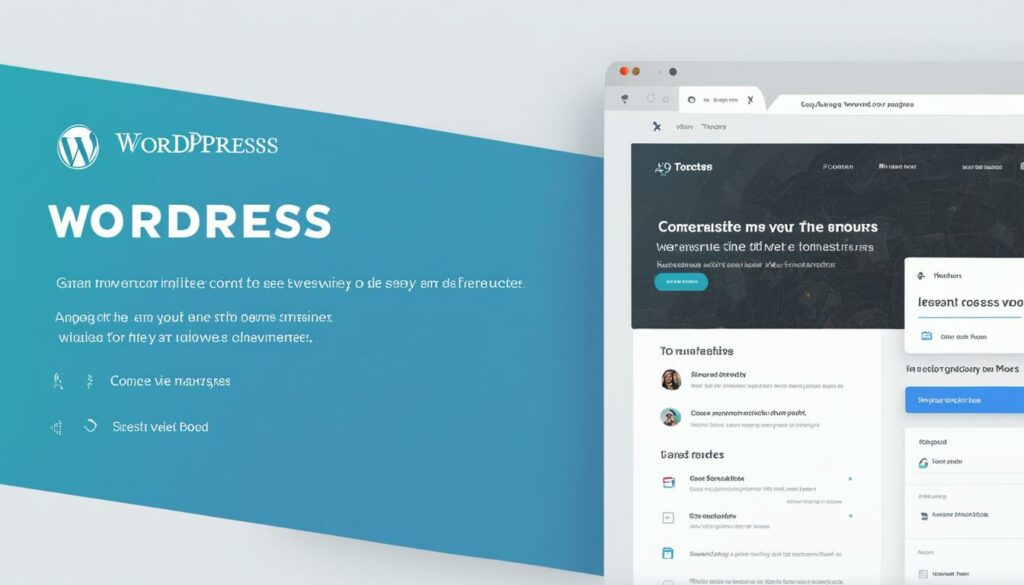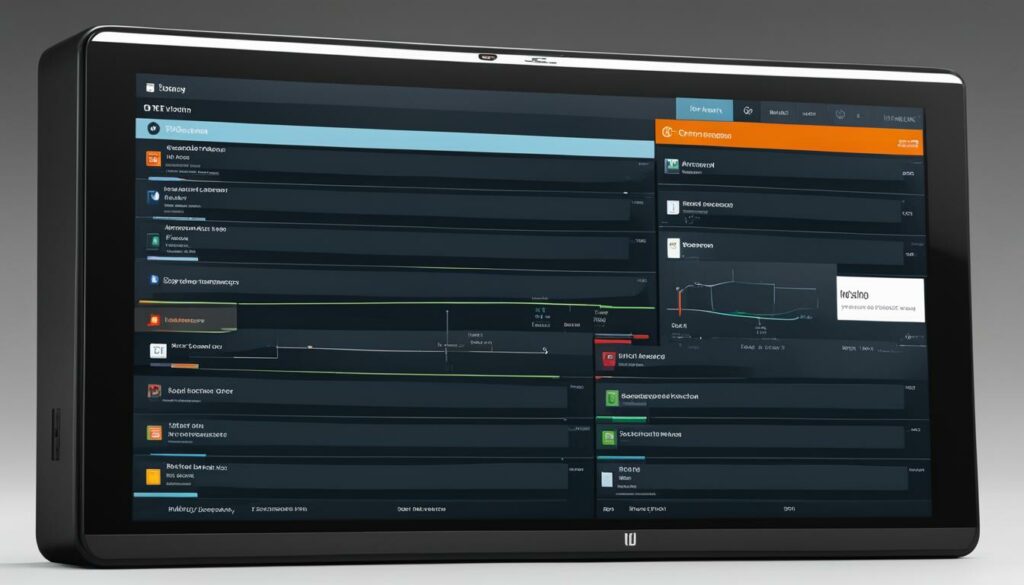Welcome to our complete overview of enhancing user experience on WordPress. In today’s digital landscape, creating accessible and user-friendly websites is more important than ever. By optimizing your WordPress site for accessibility, you can ensure that all visitors, regardless of their abilities, can navigate and interact with your content effectively.
Web accessibility refers to the inclusive design and development of websites that can be used by people with disabilities. It involves adhering to WCAG (Web Content Accessibility Guidelines) and ADA (Americans with Disabilities Act) compliance standards, which promote equal access and usability for all users. By implementing these guidelines, you can make your site screen reader compatible, optimize keyboard navigation, and improve alt text descriptions for images.
With the help of assistive technologies, such as screen readers or alternative input devices, people with disabilities can access and engage with your content. By focusing on inclusive design and accessibility, you create a more inclusive online environment that caters to a wider audience and enhances the overall user experience on your WordPress site.
Throughout this overview, we will explore various strategies and optimization tips to enhance the user experience on WordPress. From design and navigation to performance and security, each aspect plays a crucial role in creating a user-friendly environment that attracts and retains users.
Key Takeaways:
- Optimizing your WordPress site for accessibility is essential to ensure all users can access and navigate your content effectively.
- Adhering to WCAG guidelines and ADA compliance standards promotes equal access and usability for people with disabilities.
- Implementing inclusive design principles and assistive technologies enhances the overall user experience on your WordPress site.
- Throughout this overview, we will explore strategies for enhancing design, navigation, performance, security, and content readability.
- By prioritizing user experience, you can optimize your WordPress site for better engagement, user satisfaction, and ultimately achieve your business goals.
Now, let’s dive into the various aspects of enhancing user experience on WordPress and learn valuable tips to improve your site’s overall usability.
The Impact of Design on User Experience
Design plays a crucial role in enhancing the user experience on WordPress sites. It goes beyond aesthetics and focuses on creating a smooth and intuitive user experience. By implementing thoughtful design principles, you can create a website that not only looks visually appealing but also engages and delights your users.
Visual appeal and brand identity are important aspects of design that contribute to making a positive first impression on your visitors. By incorporating your brand elements, such as colors, logos, and fonts, you can establish a cohesive and memorable visual identity that resonates with your target audience.
User-centric layouts are designed with the user’s needs and behaviors in mind. They ensure that important information is easily accessible and navigation is intuitive. By organizing your content in a logical and structured manner, you can guide your users through your website seamlessly.
Consistency in design elements is key to providing a cohesive and familiar user experience. By maintaining consistency in your typography, color schemes, and overall design language, you create a sense of harmony and make it easier for users to navigate and interact with your site.
Accessibility is another crucial aspect of design that cannot be overlooked. By following accessibility best practices and ensuring that your website is accessible to all users, including those with disabilities, you create an inclusive and welcoming environment for everyone.
Engaging users through interactive design elements is a powerful strategy to enhance the user experience on your WordPress site. Whether it’s through interactive animations, sliders, or dynamic forms, adding interactivity can make your site more engaging and memorable.
When designing your website, it’s important to strike a balance between visual complexity and loading times. While high-resolution images and intricate designs can be visually appealing, they can also impact your site’s performance. Optimizing your images and carefully considering the visual complexity of your design will help ensure fast loading times without compromising on visual appeal.
Design is not just about making things look pretty; it’s about creating an experience that is visually captivating, user-friendly, and accessible to all. By prioritizing good design principles on your WordPress site, you can significantly improve the overall user experience and leave a lasting impression on your visitors.
Why Design Matters
“Design is not just what it looks like and feels like. Design is how it works.” – Steve Jobs
Design impacts every aspect of your website, from how users navigate and interact with your content to how they perceive your brand. A well-thought-out design can not only increase user engagement but also drive conversions and customer loyalty. It’s not just about creating something that looks visually appealing; it’s about providing a seamless and enjoyable user experience that keeps users coming back for more.
Creating a User-Centric Design
When designing your WordPress site, it’s important to put yourself in the shoes of your users. Think about their needs, goals, and preferences. By understanding your target audience, you can create a user-centric design that caters to their specific requirements.
- Identify your target audience: Define who your target audience is and what they are looking for. This will help you tailor your design to their needs.
- Focus on usability: Make sure your website is easy to navigate and that users can find what they’re looking for quickly and efficiently.
- Keep it simple: Avoid clutter and unnecessary complexity. A clean and minimalistic design is often more effective in conveying your message and engaging users.
- Use clear calls-to-action: Guide your users towards desired actions by using prominent and visually appealing calls-to-action.
Optimizing for Mobile Users
In today’s mobile-first world, it’s essential to design your WordPress site with mobile users in mind. With more and more users accessing the web from their phones and tablets, it’s crucial to provide a seamless mobile experience. Responsive design, which adapts your site’s layout to different screen sizes, is a must-have feature for any modern website.
By considering the impact of design on user experience and implementing user-centric design principles, you can create a visually appealing, engaging, and intuitive WordPress site that keeps your users coming back for more.
Optimizing Website Navigation for a Seamless Experience
Website navigation is a crucial aspect of enhancing the user experience on WordPress sites, especially for eCommerce sites using WooCommerce. By organizing your WooCommerce products in a user-friendly manner and providing streamlined browsing options, you can ensure that users can easily find what they’re looking for.
One of the key elements in optimizing website navigation is designing a clear and concise user-friendly menu. A well-structured menu helps users quickly understand the site’s structure and easily navigate to different sections. By categorizing products effectively and creating logical menu hierarchies, you can improve the user experience and make it easier for users to explore your offerings.
Additionally, implementing a robust search feature is crucial for enhancing website navigation. A robust search functionality enables users to directly locate products or information they need, reducing the time and effort spent on browsing through different pages. By providing a search bar prominently on your site and ensuring that it returns accurate results, you can greatly improve user satisfaction and increase successful interactions with your site.
Here are a few optimization tips for enhancing website navigation:
- Design a user-friendly menu that clearly presents different sections and categories of your site.
- Categorize your WooCommerce products effectively to streamline the browsing experience.
- Include a prominent search bar with a robust search feature to enable users to find products or information quickly.
By optimizing your website navigation, you can create a seamless browsing experience for your users, ultimately improving their satisfaction and increasing their engagement with your site.
Example of a user-friendly menu:
| Product Category | Featured Products | New Arrivals |
|---|---|---|
| Electronics | Laptop | Smartphone |
| Apparel | T-Shirts | Jeans |
| Home & Living | Furniture | Decor |
“A well-structured menu and a robust search feature are the pillars of a user-friendly website navigation.”
Remember, a user-friendly menu and a robust search feature are essential for optimizing website navigation. By categorizing your products effectively and ensuring a seamless browsing experience, you can enhance the user experience and keep your visitors engaged.
The Importance of Website Performance for User Experience
When it comes to providing an exceptional user experience on your WordPress site, website performance plays a crucial role. Slow page loading times can be frustrating for your visitors and may lead to increased bounce rates. To keep users engaged and satisfied, it’s essential to optimize your site’s page loading speeds.
There are several strategies you can implement to improve website performance and ensure fast loading speeds. One effective approach is to utilize caching solutions. Caching helps store certain elements of your site, such as images and CSS files, so they can be quickly retrieved and displayed to users, reducing overall load times.
In addition to caching, image compression is another optimization technique that can significantly enhance website performance. Compressing images reduces their file sizes without compromising quality, allowing them to load faster on your site.
Simplifying your site code is also a crucial factor in achieving fast loading speeds. Complex and bloated code can slow down your site’s performance. By streamlining and optimizing your site’s code, you can reduce unnecessary elements and improve overall loading times.
Optimizing Website Performance Strategies:
- Implement caching solutions to store and retrieve site elements quickly
- Compress images to reduce their file sizes and improve loading speeds
- Simplify site code to eliminate unnecessary elements and enhance performance
Fast loading speeds are essential for providing a seamless user experience. By optimizing your WordPress site’s performance through caching, image compression, and simplifying site code, you can ensure that your visitors have a smooth and efficient browsing experience.
Take a look at the following table for a comparison of different optimization strategies:
| Optimization Strategy | Benefits |
|---|---|
| Caching Solutions | Reduced page loading times, improved user experience |
| Image Compression | Faster image loading, minimized bandwidth usage |
| Simplifying Site Code | Streamlined performance, enhanced site speed |
By implementing these optimization strategies, you can create a website that not only looks visually appealing but also delivers a fast and efficient user experience. This will help keep your visitors engaged, reduce bounce rates, and ultimately drive better results for your WordPress site.
Enhancing Security for a Trustworthy User Experience
Ensuring website security is an essential element of providing a trustworthy user experience. By implementing various security measures, you can protect your WordPress site from potential threats and unauthorized access.
One effective security measure is two-factor authentication, which adds an extra layer of protection by requiring users to provide additional verification, such as a unique code sent to their mobile device, along with their password.
Regular updates are crucial for maintaining website security. This includes updating not only the WordPress core but also themes and plugins. By keeping your site up to date, you can patch security vulnerabilities and protect against potential attacks.
Another important security aspect is the use of SSL certificates. SSL certificates encrypt data transmitted between the user’s browser and your website, ensuring a secure connection. This encryption protects sensitive information, such as login credentials and payment details, from being intercepted by hackers.
Furthermore, choosing a secure hosting provider is essential for safeguarding your website. Look for a reputable hosting provider that offers robust security features and regular backups to prevent data loss.
To summarize, enhancing website security through measures such as two-factor authentication, regular updates, SSL certificates, and secure hosting is crucial for providing a trusted and secure user experience.

The Benefits of Enhancing Website Security:
- Protection against unauthorized access
- Reduced risk of data breaches
- Increased user trust and confidence
- Secure transmission of sensitive information
- Prevention of malicious attacks
“Investing in website security not only protects your users but also safeguards your online reputation and business integrity.”
By prioritizing website security and implementing measures like two-factor authentication, regular updates, SSL certificates, and secure hosting, you can create a safe and secure environment for your users, fostering trust and confidence in your WordPress site.
The Importance of User Experience in WordPress Sites
User experience (UX) is a critical factor in the success of WordPress sites. It plays a key role in setting a good first impression of your brand, increasing sales, improving user retention rates, and enhancing search engine optimization. When users have a positive experience on your site, it establishes trust, encourages repeat visits, and ultimately leads to better conversions.
A user-friendly environment is essential for attracting and retaining customers. By prioritizing user experience, you can create a website that is easy to navigate, visually appealing, and highly functional, ensuring that users have a seamless and enjoyable browsing experience.
One of the primary benefits of a good user experience is the ability to set a good first impression of your brand. When visitors land on your WordPress site, they should immediately feel engaged, excited, and confident in your products or services. A well-designed and user-centric website helps to establish credibility, professionalism, and trust from the get-go.
“A positive first impression can be the difference between capturing a potential customer’s interest or losing them to a competitor.”
In addition to setting a good first impression, user experience also has a direct impact on sales. When your WordPress site is optimized for usability and provides a seamless purchasing process, it becomes easier for users to make a purchase. Clear navigation, intuitive product search, and streamlined checkout processes all contribute to a smoother user journey, reducing friction and increasing conversion rates.
Furthermore, a good user experience improves user retention rates. When visitors have a positive experience on your WordPress site, they are more likely to return and engage with your content or products on an ongoing basis. By consistently delivering a high-quality user experience, you can build loyalty and keep users coming back for more.
Finally, user experience plays a crucial role in improving search engine optimization (SEO). Search engines like Google prioritize user-friendly websites that offer valuable and engaging experiences. Factors such as page load speed, mobile responsiveness, and accessible design all contribute to a positive user experience, which in turn improves your website’s visibility in search engine results.
In conclusion, the importance of user experience in WordPress sites cannot be overstated. By prioritizing UX, you can set a good first impression, increase sales, improve user retention rates, and enhance search engine optimization. A positive user experience leads to better conversions, customer loyalty, and overall business success.
The Role of Simple Design and Easy Navigation
Simple design and easy navigation are key elements in improving the user experience on WordPress sites. A simple design enhances usability and functionality, allowing users to easily navigate the site. Including site menus, navigation bars, categories, search tools, and archives pages improves the user experience by providing clear paths for users to find the information they need. A simple and intuitive design reduces user frustration and enhances overall user satisfaction.
Incorporating a functional design with easy navigation elements ensures that users can effortlessly explore your website. By prioritizing a clean and user-friendly interface, you create a seamless browsing experience that keeps visitors engaged and satisfied. Simple design elements, such as clear typography, ample white space, and intuitive layout, contribute to a visually appealing website that is easy to navigate.
- Streamline your site menus to contain relevant categories and subcategories, making it easier for users to locate information or specific pages.
- Include a visible search tool that allows users to quickly search for specific content or products.
- Implement navigation bars or sidebars that feature essential links or useful widgets.
- Use breadcrumb navigation to help users understand their location within your site’s structure.
A site with simple design and easy navigation enhances usability, ensuring that visitors can effortlessly find what they’re looking for. This positive user experience encourages longer browsing sessions, boosts engagement, and increases the likelihood of conversions.

Usability and Functional Design
“Good design is obvious. Great design is transparent.” – Joe Sparano
Achieving usability and functional design is vital for providing a seamless user experience. A functional design focuses on the needs and expectations of your target audience, delivering information and features in a way that is intuitive and efficient for users to navigate and interact with.
The visual appeal of your WordPress site should not compromise its functionality. Prioritize simplicity, clarity, and consistency in your design choices. Avoid excessive visual distractions and unnecessary elements that may confuse or overwhelm users. Instead, adopt a minimalist approach that highlights the key features and content of your site.
Consider using intuitive icons and symbols that users can easily recognize and associate with specific actions or functionality. Use appropriate color schemes to enhance readability and create visual harmony. Choose fonts and typography that are legible and accessible across different devices and screen sizes.
A well-designed and functional WordPress site promotes a positive user experience by allowing visitors to effortlessly navigate, find information, and engage with your content. By ensuring your design elements are user-centric and align with your target audience’s preferences, you create a user-friendly environment that encourages interaction and drives conversions.
The Importance of a Useful and Informative Homepage
The homepage of your WordPress site plays a crucial role in the overall user experience. It is often the most viewed page and sets the tone for visitors’ interactions with your site. By creating a useful and informative homepage, you can make a positive first impression and engage users right from the start.
One effective way to enhance your homepage is by using feature boxes. These eye-catching boxes can be strategically placed to introduce your site’s offerings and encourage users to take specific actions, such as signing up for deals or information. Feature boxes not only grab attention but also provide valuable information that entices users to explore further.
When designing your homepage, consider the importance of content presentation. Organize your content in a visually appealing and logical manner, making it easy for users to find what they are looking for. Use headings, subheadings, and bullet points to break up the text and make it more scannable and digestible.
Remember, your homepage sets the stage for users’ entire experience on your site. Make it informative, engaging, and visually appealing to create a favorable impression and encourage users to explore more.
Improving Content Readability for Better User Experience
Content readability is a crucial aspect of the user experience on your WordPress site. When your content is visually appealing and easy to read, it attracts and engages users, encouraging them to spend more time on your site. To enhance content readability, consider implementing the following strategies:
Catchy Headlines
Catchy headlines grab the reader’s attention and entice them to read further. Use descriptive and intriguing headlines that accurately represent the content.
Bullet Points
Break your content into easily digestible chunks using bullet points. This helps users quickly scan the information and grasp the main points.
Appropriate Line Height
Ensure that there is enough spacing between lines of text. Adequate line height improves readability and prevents the content from feeling cramped.
Readable Fonts
Choose fonts that are easy to read. Avoid fancy or overly stylized fonts that can make it difficult for users, especially those with visual impairments, to read the text.
In addition to these strategies, structuring your content into well-organized paragraphs and using subheadings can further enhance readability. When your content is visually appealing, easy to navigate, and presents information in a clear and concise manner, it contributes to a better user experience on your WordPress site.
Enhancing User Experience with Eye-Catching Elements
When it comes to enhancing the user experience on your WordPress site, incorporating eye-catching elements is key. Visual variety and engagement play a crucial role in capturing and holding your audience’s attention. By incorporating infographics, charts, and quotes into your content, you can create a more dynamic and visually appealing user experience.
Infographics are a powerful tool for conveying complex information in a visually appealing and easy-to-understand format. They provide an excellent way to break up textual content and offer a visually stimulating and interactive experience for your users.
Charts are another effective way to present data and statistics in a visually engaging manner. Whether you’re showcasing trends, comparisons, or other key information, charts can help users quickly grasp and interpret the data you’re presenting.
Incorporating relevant quotes from industry experts or satisfied customers can also add value to your content and captivate your audience. Quotes provide a human element and can serve as powerful testimonials or persuasive statements that support your message.
By utilizing these eye-catching elements, you can enhance the overall user experience on your WordPress site. Visual variety and engagement increase user satisfaction and encourage active interaction with your content.
Example of an Infographic:
Benefits of Eye-Catching Elements:
| Benefits | Description |
|---|---|
| Enhanced Engagement | Eye-catching elements capture and hold users’ attention, increasing their engagement with your content. |
| Improved Comprehension | Infographics and charts visually present complex information, making it easier for users to understand. |
| Enhanced Visual Appeal | Eye-catching elements break up text-heavy content, making it visually appealing and reducing reader fatigue. |
| Increased Shareability | Visual content is more likely to be shared on social media platforms, increasing your reach and visibility. |
By incorporating eye-catching elements into your WordPress site, you can create a visually engaging and interactive user experience that keeps your audience coming back for more.
The Importance of Call-to-Actions for User Engagement
Call-to-actions are crucial elements on your website that drive user engagement and increase conversion rates. By implementing features such as popups, forms, and chat options, you can encourage users to interact with your site and take specific actions that benefit your business.
Call-to-actions prompt users to make inquiries, sign up for services, or complete transactions, ultimately enhancing the overall user experience and increasing user engagement and interaction on your WordPress site.
Popups
Popups are attention-grabbing elements that appear on your website, capturing the user’s attention and directing them towards a specific call-to-action. By using strategically placed popups, you can effectively communicate important messages, offer exclusive deals, or encourage users to sign up for your newsletter. Popups help drive user engagement and boost conversions by guiding users towards the desired action.
Forms
Forms play a vital role in collecting user data, capturing leads, and facilitating communication between your business and users. Whether it’s a contact form, registration form, or feedback form, optimizing the design and placement of forms can significantly improve user engagement. Well-crafted forms with clear instructions and minimal fields help reduce friction, making it easier for users to complete the desired action.
Chat Options
Integrating chat options, such as live chat or chatbots, provides users with immediate access to support and assistance. Real-time communication enhances the user experience by addressing user queries and concerns promptly. Chat options also help guide users through the conversion process, leading to higher engagement and increased conversion rates.
| Benefits of Call-to-Actions | |
|---|---|
| 1. Increased User Engagement | Call-to-actions help capture user attention and encourage active participation on your website. |
| 2. Higher Conversion Rates | Strategically placed call-to-actions prompt users to take specific actions, boosting conversion rates and driving business growth. |
| 3. Improved User Experience | Efficient call-to-actions enhance the overall user experience by providing clear guidance and facilitating smooth interactions. |
By leveraging the power of call-to-actions, you can optimize user engagement, increase conversion rates, and ultimately drive the success of your WordPress site.

Conclusion
To attract and retain users, it is crucial to prioritize the improvement of user experience (UX) on your WordPress site. By focusing on key areas such as design, navigation, performance, security, and content readability, you can create a user-friendly environment that enhances user satisfaction and engagement.
Implementing optimization tips can significantly improve your site’s UX. Start with a simple and visually appealing design that provides easy navigation for users to find what they need quickly. Optimize your site’s loading speeds to reduce waiting times and ensure a smooth browsing experience.
Enhance security measures by implementing two-factor authentication, regularly updating your WordPress site and its components, and obtaining SSL certificates to secure user data. Additionally, ensure that your content is readable and easily digested by using catchy headlines, bullet points, readable fonts, and well-structured paragraphs.
By implementing these optimization tips and focusing on improving the user experience, you can create a WordPress site that offers an enjoyable and seamless experience for your users, ultimately leading to increased user engagement and the achievement of your business goals.
FAQ
Q: What is WordPress Accessibility?
A: WordPress Accessibility refers to the practice of making websites built on the WordPress platform inclusive and usable for all users, including those with disabilities. This involves following WCAG (Web Content Accessibility Guidelines) guidelines and ensuring webpages are screen reader compatible, have keyboard navigation options, and optimized alt text for images.
Q: Why is web accessibility important for WordPress sites?
A: Web accessibility is important for WordPress sites because it ensures that people with disabilities can access and navigate websites effectively. It also helps websites comply with ADA (Americans with Disabilities Act) regulations and improves overall user experience for all visitors.
Q: What are some key guidelines for creating accessible websites on WordPress?
A: Some key guidelines for creating accessible websites on WordPress include providing alternative text for images, using headings and subheadings properly, ensuring keyboard navigation is possible, using high contrast colors for better readability, and creating content that is easily understood by screen readers.
Q: How can I make my WordPress site more inclusive for all users?
A: To make your WordPress site more inclusive, you can focus on inclusive design principles such as using readable fonts and contrasting colors, offering text alternatives for non-text content, providing captions for videos, designing elements that are easily navigable using a keyboard, and testing your site with assistive technologies like screen readers.
Q: How can I optimize website navigation for a better user experience?
A: To optimize website navigation for a better user experience, you can create clear and concise menus, implement a robust search functionality, organize products or information into categories, and use breadcrumb navigation to indicate the user’s location on the site.
Q: How important is website performance for user experience on WordPress sites?
A: Website performance is crucial for a positive user experience on WordPress sites. Slow page loading times can lead to user frustration and increased bounce rates. By optimizing page loading speeds through caching solutions, image compression, and simplifying site code, you can improve user satisfaction and engagement.
Q: How can I enhance website security for a trustworthy user experience?
A: To enhance website security for a trustworthy user experience, you can implement two-factor authentication for user login, regularly update WordPress core, themes, and plugins, obtain SSL certificates to encrypt data transmission, and choose a reputable hosting provider with robust security features.
Q: How does user experience impact the success of WordPress sites?
A: User experience is crucial for the success of WordPress sites as it sets a good first impression, increases sales by making the purchasing process easy and straightforward, improves user retention rates, and enhances search engine optimization. A positive user experience helps establish trust, encourages repeat visits, and leads to better conversions.
Q: How can I improve content readability for better user experience?
A: To improve content readability for better user experience, you can use catchy headlines, bullet points, appropriate line heights, and readable fonts. Structuring paragraphs effectively and providing valuable and informative content also enhance readability and user engagement.
Q: How can I enhance user experience with visually appealing elements?
A: You can enhance user experience with visually appealing elements by including infographics, charts, and quotes in your content. These elements break up textual content, provide variety, and increase user engagement. Infographics are especially useful for conveying complex information in an easy-to-understand format.
Q: How do call-to-actions improve user engagement on WordPress sites?
A: Call-to-actions, such as popups, forms, and chat options, encourage users to interact with your site and take specific actions. These features enable users to make inquiries, sign up for services, or complete transactions, thereby enhancing user engagement and interaction on your WordPress site.
Q: What are some optimization tips for enhancing the user experience on WordPress sites?
A: Some optimization tips for enhancing the user experience on WordPress sites include focusing on web accessibility, improving website navigation and performance, enhancing security measures, creating simple and user-friendly designs, and providing valuable and readable content. Prioritizing user experience helps to create a user-friendly environment that attracts and retains customers.












